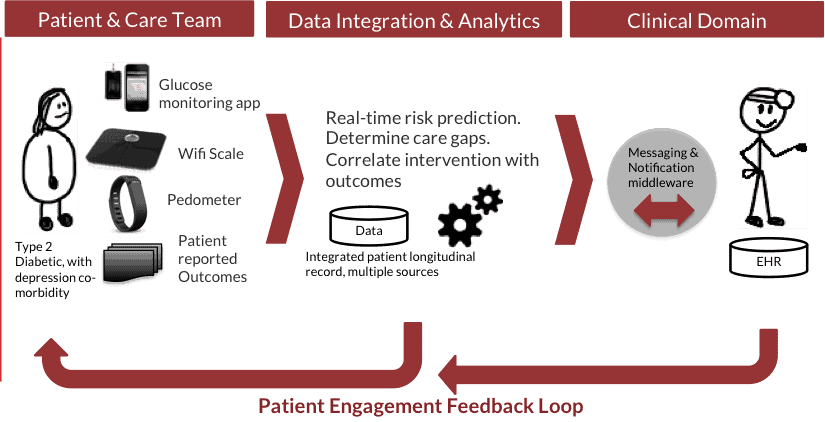Real-time population health usecases are everywhere in healthcare. Imagine a patient recently diagnosed with congestive heart failure (CHF). As soon as his physician saves the new diagnosis within the EHR, the patient is automatically enrolled in a program and sent an email. As part of the program, the patient steps on a wifi scale every day at home; an alert is surfaced back to the physician when a sudden weight gain is detected. This type of real-time patient/population health management is happening today, albeit as pilots versus anything at scale across a population.
In an ideal world, real-time data — including user generated data, mobile, and social data — will simply arrive and be acted upon. The clinical care team, extended care team, and the patient will receive the necessary alerts and outreach, via the appropriate channel chosen. Outcomes will be tracked, and predictive models will be automatically refined based of feedback loops built into the system.
This kind of care management utopia would enable care processes to move beyond bricks and mortar and towards the consumer/home:

On the other side of the fence, payers have had the necessary incentives — but have had to make due with adjudicated claims data (or, “paid claims”) in their attempts at population monitoring/preventing adverse events – a less than ideal dataset if one wishes to do real-time, population health management.
Paid Claims: The Data Timeliness Villain. Paid claims data continue to be disparaged by providers as stale and shallow — even as these same providers have come around and now grudgingly accept paid-claims data as necessary for detecting leakage and total cost of care.
Even payers experience a lag time of roughly a month when it comes to analyzing aggregate paid-claims data stores — when all is said and done. Companies like ActiveHealth Management have struggled with this timeliness issue as their vision is to monitor population health in real-time.
Coming from the provider perspective, this timeliness issue is even more aggravating. MSSPs wait months for the initial drop of CMS claims data. On the commercial side, providers working with commercial payers find themselves in the “wild west” when it comes to gaining timely access to these paid-claims.
Beyond Paid-Claims. But wait – the payer side has more to offer than paid-claims data. There are also the data that flows through EDI networks (eligibility checks, referrals, …), and now we see EDI vendors, e.g. NaviNet, formulating PHM offerings that center around leveraging these transactions across their networks. These efforts remain in very early stages and currently focus on fairly mundane but important issues such as leakage.
On the PBM side, the Surescripts network also offers access to eligibility data and med-fill data — a capability that has already been leveraged by many vendors. Specifically Kryptiq (acquired by Surescripts) is currently leveraging these eligibility checks to shine a light on leakage in real-time, within the interface of its Care Manager solution.
Enter Provider-Housed Data Sources. And then there are provider-owned data sources that tend to be more real-time in nature: PMS/billing, labs, ambulatory EHR, inpatient HIS.
Note: The marketing term “real time” is currently up for debate. Usually this means near real time (hourly or nightly). EHRs and labs tend to refresh nightly or weekly. However, the overall trend is for faster refresh rates across all data types.
Granted, clinical data is currently a mess. Data Quality (DQ) problems abound — and high DQ and sufficient trust in the data are precursors to building out real-time alerting usecases. The provider sector as a whole has quite a long ways to go to clean up its data.
HIE vendors tend to be ahead in terms of thinking about real-time alerts that are driven off of clinical data, though most vendors simply just tap into ADT for readmissions usecases. The only vendor that has built up significant real-time clinical alerting capabilities is CareEvolution, a small private HIE vendor based in Ann Arbor, and others we have spoken to are currently building out similar functionality.
How Do We Get People to Pay Attention? This remains the most pressing question. Payers have been trying to get physicians and patients alike to pay attention to their communications for more than a decade, with little success. In speaking with clinicians, most simply say that payer reports are dated, often incomprehensible, relatively meaningless and thus ignored.
Ongoing, real-time population monitoring is just the beginning, a beginning that will need to overcome a number of challenges, chief among them data quality. Cascading the necessary alerts, based on quality datasets into a provider universe that still reels from order-set alerting, and actually getting them noticed — will be the next challenge.




0 Comments